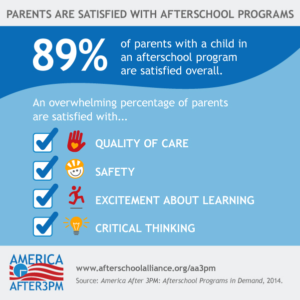A national survey conducted by the Afterschool Alliance revealed that 20% of children are left unsupervised after school lets out. As of fall 2018, approximately 56.6 million children attend elementary and secondary schools across America, while 1.4 million and 3.6 million attend Pre-K or kindergarten respectively (1). According to the NCES or National Center for Education Statistics, this number is projected to grow by nearly 2 million by 2027. Of these 56 million children, only 10.2 million attend afterschool programs while 19 million would attend some sort of program if there were any available to them (2). On average, children that were not enrolled in an afterschool program spent 7 hours per week totally unsupervised (2). Researchers have found that the demand for after school programs is continuing to grow and is not being met. For every child enrolled in an afterschool program, there are 2 children on the waitlist. To give an approximate figure, 10.2 million children are currently enrolled in after school programs, which means there are nearly 20 million children on a waitlist. This does not include the demand of families that live in rural areas. In rural areas there are 1 million children enrolled in afterschool programs, and for every child enrolled there are 3 children waitlisted (2).
 Why does this matter?
Why does this matter?
According to the AfterSchool Alliance, between 3pm and 6pm unsupervised children are more likely to commit crimes, become victim of crimes, or engage in unsafe or illegal activities (2). Eighty-three percent of parents claim that putting their children in an afterschool program reduced the likelihood of their children committing a crime or engaging in unsafe activities. Not only do afterschool programs keep children safe, but research has also shown that afterschool progams helped children to excel academically, improve their behavior, develop a love for learning, improved critical thinking, and develop healthier eating habits and nutrition (3). In addition, 89% of parents felt satisfied with the afterschool programs and also felt a peace of mind knowing their children are safe; parents also mentioned that afterschool programs helped them to keep their jobs (3). Afterschool programs have also shown to create a solid foundation for children’s future successes both academically and socially (4).

